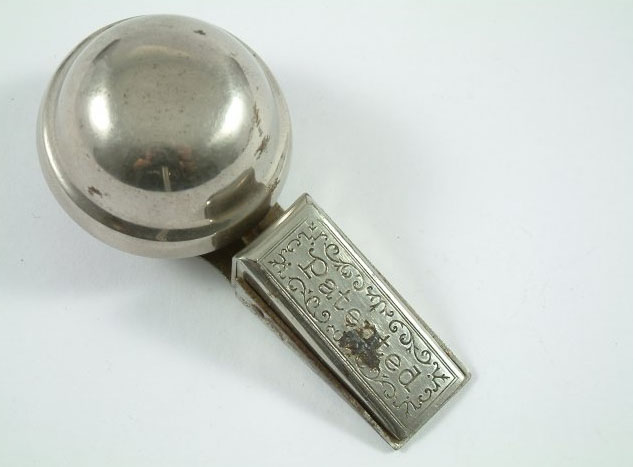Victorian Gadgets

"Weird, eccentric and everyday gadgets, contraptions and oddities from the past"
How the collection started
It all started down a hole in the ground on a Victorian rubbish dump in North London, my son, aged 13 decided that he wanted to dig for old bottles and pot lids on a local dump which he saw others teenagers were doing on the programme ‘Blue Peter' in the seventies.
So here we were, down this rather dirty damp trench in bad weather, and what was emerging from the earthy wall was an oblong pointed bottle that obviously was meant not to stand up! How intriguing, a bottle that was impossible to stand on its own 2 feet, ‘what was the point?' (no pun intended), thus began my interest in patents, inventions and weird contraptions!
To enlighten you to the answer of this engaging puzzle and the reason why this bottle could not stand, up was to ensure that the cork was always kept damp, the contents was sparkling mineral water which by a process invented in the late 18th century by a gentleman called Joseph Priestley, that imitated the water that the upper classes would ‘take' at the various spa towns. The bottle itself was invented by William Hamilton in 1814 and in fact continued for nearly 100 years, even when competition from the more famous mineral water container, called the Codds bottle invented by Hiram Codd came along in the 1880's, this was a normal bottle that contained a marble and a washer, when the bottler filled the sparkling water or lemonade the gas forced the marble into the washer and sealed the gas from escaping, the saying "what a lot of codd's wallop" derived from this process. Victorian kids had a great time breaking the bottles for the marble!
Just a little research had opened for me an amazing and interesting aspect of how people over the last 100 years had used technology in their everyday life, those little innovations that had been forgotten or never manufactured, or perhaps had evolved into the many gadgets and contraptions we use today, without ever thinking how our forbears solved problems 100 years ago. I resolved to try to collect the minutia of everyday life, those ingenious products that attempted to solve a human difficulty, be it in the kitchen, home, office or leisure activity.
Developing the collection
But I did need to set some parameters to the collection, I had to define how I would select my purchases, would it be any product that had been produced between 1851 - 1951 (The Great Industrial Exhibition and The Festival of Britain) or did I need some other measures, as far as I can now retrospectively workout there was some sub conscious rules, the item should be solving a problem in an unusual way, would, if possible, be powered and have a working element of some description, would have an aesthetic quality or was so outrageous that it just had to be a part of the collection.
One of the biggest changes that occur in the development of any product is the way they are energised, the problem is usually the same, lets take washing clothes, at first, by the river, womenpummelled the clothing with their hands or some stone implement to get the dirt removed, then a metal circular object placed on the end of a stick served as the ‘agitator', then, in the mid 19th century, in wood, the first washing machine was created, the inside of a box (drum) had a range of ridges, this was attached to an outside wheel by the way of an axle, that had to be turned as rapidly as possible to push the clothes against the ridges to remove the dirt, aided of course by soap and water, when finished, and believe me it's hard work, the water is removed and the clothes put through an attached mangle, (wringer for the youngsters reading this article). All those features the washing machine of today has, a drum, with ridges that agitates, but powered by electricity!
The principle of the development of the method of propulsion is woven into thousands of innovations from the past, can you imagine a ‘Teasmaid' powered by clockwork, in my collection is the first mechanical, clockwork driven maker of a cuppa, as you wake up. Simply, you set the time on the alarm clock, when the bell rings, a lever pushes another lever which causes a match to strike, which then lights an oil fire, when the kettle boils, a steel plate cuts across the flames putting them out, and the water is poured from the kettle into the teapot alongside the machine, perhaps one of the most dangerous fire hazard in the collection!
Keeping flies off your food in the summer wouldn't seem to much of a problem, after all you can just cover the food with a cloth, but some Victorian entrepreneur thought, that a fly scarer would earn him a fortune, so, using a clockwork device, attached to 2 long paddles, much like a propeller, then switching a lever caused the paddles to turn very slowly over the dinner table thus keeping the dinner unravaged by the flying insects. A most amazing problem solver, sadly I don't think that the inventor gave up his day job!
In my collection is over 1500 items from tiny patented cuff links, which was also used by card sharps to hide the ace, to full sized washing machines and vacuum cleaners. To give you a feel for the collection just enter this site and marvel at the ingenuity of our forefathers.
Some of the collection is on show in the liverpool area for the next 2 months at croxteth hall, liverpool and will be at other museums around the country.

